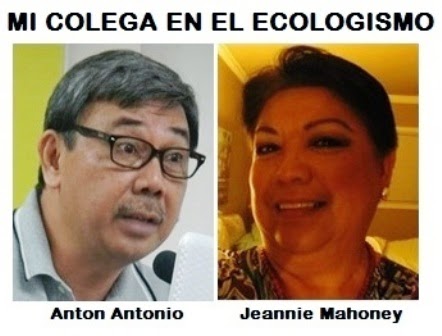A WORTHY ADVOCACY TO CHAMPION
by Antonio C. Antonio
August 29, 2014
If you will be a
champion in an environmental advocacy, what or which environmental issue would
you like to work on? What approach will you use? Explain the global
significance of your advocacy.
If I were to choose an environmental advocacy, I would
choose “Participatory Public Policy Review in the Philippine Uplands” to
promote environmentalism and social justice.
Among the approaches identified by Tearfund, I am inclined
to prefer Column No. 2 (Mixture of NGOs, professionals and local
community). Column No. 3 (Local
people/groups) is seemingly a miniscule group that may not be able to influence
public policies while Column No. 1 (NGOs, trade unions, political
representatives, professionals, etc.) is a “too-broad” group that will be very
hard to handle. Besides, the presence of
politicians (who represent a “dole out” regime/dispensation) and unions
(normally militant and self-indulging) may be a bad combination and a failure
waiting to happen. The more important
goals would be (1) to encourage participation among the stakeholders, (2) to
hasten decision-making processes, (3) to review and revise inconsistent and
non-applicable public policies, (4) to encourage a sustainable advocacy among
the stakeholders, (5) to attract outside intervention, assistance and support,
(6) to get the stakeholders involved in problem identification and strategy
formulation, and (7) to increase the knowledge and awareness of the
stakeholders on specific issues that affect them. These objectives are attainable using a
“mixture of NGOs, professionals and local community”. The prospect of NGOs controlling and setting
the agenda will be more acceptable than politicians or government agencies
dominating this “mix” of advocacy development participants.
To review
what is actually happening at present and to understand the peculiarities of
the Philippine uplands, please allow me to reprint a portion of an article I
wrote before:
“The
normal practice in upland governance is to organize “multi-sectoral
taskforces/committees” to deliberate, implement and monitor programs and
projects and (oftentimes) bestow upon them extra-ordinary police,
administrative and controlling powers. These taskforces/committees are
usually composed of the following:
·
DENR representatives from the National, Regional, Provincial and
Community Offices;
·
Local Government Unit (LGU) representatives from the Provincial
and Municipal Governments;
·
People’s Organizations (PO) representative (more often) coming
from the Indigenous People’s organization/community (IPs) in the affected
areas;
·
Civil Society representatives (more often) coming from the
environment advocacy groups; and,
·
The private proponents or investors.
This sort
of power is very dangerous in the hands of people to know less of what is
expected of them. Please consider the following possible scenario:
·
The DENR representatives, perceived to be corrupt, will often
leave glitches in the system to create opportunities for corruption;
·
The LGU representatives are politicians, are easily swayed by
populist considerations and could have been elected because of popularity… not
knowhow, skill and intelligence;
·
The IP representatives are just there for a ride and would not
really know what’s going on;
·
The Civil Society/environmentalist organization representatives
are often inflexible and would always take a very militant stance… the “basta”
attitude. They are often quoted as saying: “Basta! We object!”… and
when asked to lay the basis for their objections, they will simply repeat their
rehearsed refrain: “Basta! We object!”
·
The private sector representatives, also representing business
interest, will always want to put one over the others.
As part
of the recommendation, I also made this comment: “Acts of graft and corruption
are born out of ignorance… it will be hard for people to wheel and deal when
others are in the know. Academicians could create this awareness among
the actors and motivate them to properly set up to the challenges ahead.”
(Antonio, 2013) Having said this, I
believe the inclusion of the academe in the group in Column No. 2 will be a
wise and ideal addition.
I believe
that our environment-related ills are directly related to the many confusing
public policies we have at present. As a
democracy, we are governed by laws but such laws should translate to the
betterment of lives (social justice… meaning: justice in terms of the equitable
distribution of wealth, opportunities, and privileges within a society) and the
protection of the world we live in. Our
socio-economic-political malaise is anchored on our contemptuous and twisted
view of social justice. This likewise
influences the manner by which we treat our environment.
A
comprehensive review of public policies will and should result to:
1. The
weeding out of out-dated and non-applicable laws especially those that were
promulgated prior to the 1987 Constitution directly concerning natural
resources (Philippine Constitution, Article XII, Section 2);
2. The
identification of repetitive, overlapping and conflicting laws and harmonizing
the same within the lines of social justice and environmentalism;
3. The
rationalization (meaning: organizing something into a logically coherent
system) of upland-based industries to prevent illegal extracting activities;
4. The
sustainable (meaning: the present generation’s utilization of natural resources
while leaving the same utilization capability for future generations) utilization
of resources; and,
5. The
institutionalization of environmental advocacies as a more structured system
and measure to (a) increase knowledge and awareness on environmental matters
and concerns, (b) promote participatory management in the uplands, (c)
safeguarding our natural resources; and, (d) promoting social justice.
I also believe
there are enough renewable natural resources for everyone to sustainably
utilize and there are ways to ensure that these resources are also made
available for the utilization of future generations. Our primordial concern is for the
non-utilization of non-renewable resources and the sustainable utilization of
renewable resources. Crafting the right
and ideal laws to protect both man and his environment should be everybody’s end
in mind. With this, we could be an
environment and social justice-focused democracy the world could look up
to. To me, this is a worthy advocacy to
champion.
Just my
little thoughts…













